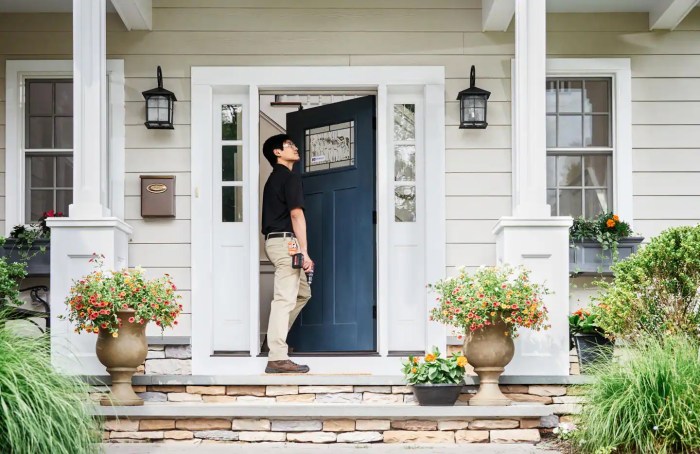Legal Requirements for Impact Doors in Storm Zones: Ensuring Safety and Compliance
Legal Requirements for Impact Doors in Storm Zones is a crucial aspect of construction in storm-prone areas, ensuring the safety and structural integrity of buildings. By understanding the building codes, regulations, and certifications involved, homeowners and contractors can make informed decisions to protect properties from potential storm damage.
Throughout this discussion, we will delve into the specifics of legal requirements, impact door certifications, design considerations, and maintenance practices essential for safeguarding homes in storm zones.
Legal Requirements for Impact Doors in Storm Zones
Living in storm-prone areas comes with the responsibility of ensuring that buildings are equipped with impact doors that meet specific legal requirements. Building codes play a crucial role in regulating the materials and installation of these doors to enhance safety and structural integrity.
Building Codes for Impact Doors
- Building codes in storm zones often require impact doors to be tested and certified to withstand severe weather conditions, such as hurricanes and strong winds.
- These codes Artikel the minimum standards for impact door materials, including impact-resistant glass and reinforced frames, to ensure durability and protection during storms.
Regulations for Materials and Installation
- Impact doors must meet specific criteria for materials, such as impact-resistant glass that can withstand high-speed impacts without shattering.
- Installation of impact doors must be carried out according to manufacturer guidelines and building codes to ensure proper functioning and effectiveness during storms.
Importance of Compliance
- Complying with legal requirements for impact doors is crucial for the safety of occupants and the overall structural integrity of buildings in storm zones.
- Failure to adhere to these regulations can result in serious consequences during severe weather events, putting lives at risk and causing significant damage to properties.
Impact Door Certification and Testing
Impact doors in storm zones must undergo rigorous certification and testing processes to ensure they meet safety and performance standards.
Certification Process
Impact doors are typically certified by organizations such as the Miami-Dade County Product Control Division or the Florida Building Code. These organizations evaluate the doors based on factors like material strength, impact resistance, and wind pressure performance.
Testing Standards
There are various testing standards used to evaluate impact doors, including:
- ASTM E1886/E1996: These standards assess a door's ability to withstand windborne debris impacts and cyclic wind pressure.
- AS/NZS 1170.2: This Australian/New Zealand standard evaluates the structural performance of doors in high wind areas.
- FM Approvals 4880: This standard focuses on impact-resistant doors and windows, testing them for resistance against forced entry and severe weather conditions.
Importance of Certification and Testing
Certification and testing processes are crucial as they ensure that impact doors are able to withstand the harsh conditions of storm zones. By meeting these safety and performance standards, impact doors provide protection for homes and buildings during hurricanes and severe weather events.
Impact Door Design and Construction
Impact doors designed for storm zones are built with specific features to withstand high winds, flying debris, and extreme weather conditions. These doors are crucial for ensuring the safety and protection of buildings and occupants during hurricanes and other severe storms.
Key Features of Impact Doors
- Reinforced frames and sashes to prevent buckling or bending under pressure.
- Laminated impact-resistant glass that can withstand strong impacts without shattering.
- Multipoint locking systems for added security and stability.
- Weather-stripping to prevent water infiltration and air leaks.
Materials Used in Construction
- Steel: Provides strength and durability, commonly used in frames and reinforcements.
- Aluminum: Lightweight and corrosion-resistant, often used for frames and hardware.
- Fiberglass: Offers high impact resistance and insulation properties, used in door panels.
- Laminated glass: Consists of multiple layers of glass and interlayer for impact resistance.
Effectiveness during Storms
Impact doors are designed and constructed to mitigate damage from storms by withstanding high winds, flying debris, and pressure differentials. The reinforced frames and impact-resistant glass ensure that the doors remain intact and secure, preventing breaches that could lead to structural failure or water intrusion.
Additionally, the weather-stripping and locking systems help seal the door against the elements, maintaining the integrity of the building envelope.
Maintenance and Inspection of Impact Doors
Regular maintenance and inspections are crucial for ensuring the effectiveness of impact doors in storm zones. By following recommended practices and conducting routine checks, homeowners can help prolong the lifespan of their impact doors and ensure they provide optimal protection during severe weather events.Explain the importance of regular inspections to ensure impact doors remain functional.
Recommended Maintenance Practices
- Regularly clean impact doors with mild soap and water to remove dirt and debris that may affect their performance.
- Inspect weather-stripping and seals for any signs of wear or damage, as these components help maintain the door's integrity during storms.
- Check hinges, locks, and handles for proper functioning, lubricating them as needed to prevent rust and ensure smooth operation.
Routine Inspections for Homeowners
- Inspect impact doors for cracks, dents, or other visible damage that may compromise their structural integrity.
- Test the door's locking mechanism to ensure it securely closes and seals against the frame to prevent water infiltration.
- Verify that impact glass remains intact and free of chips or cracks that could weaken its ability to withstand impact.
Last Point

In conclusion, Legal Requirements for Impact Doors in Storm Zones are not merely guidelines but essential safeguards that protect lives and properties during severe weather events. By adhering to these regulations, homeowners can fortify their homes and ensure peace of mind in the face of natural disasters.
FAQ Section
Do impact doors need to meet specific building codes in storm zones?
Yes, impact doors in storm zones must comply with building codes that dictate their materials, installation, and performance standards to ensure safety and structural integrity.
How often should impact doors in storm zones be inspected?
Regular inspections are recommended to ensure impact doors remain functional and capable of providing protection during storms. Yearly inspections are typically advised.
What are some common materials used in the construction of impact doors for storm zones?
Materials like reinforced steel, aluminum, and impact-resistant glass are commonly used in the construction of impact doors designed to withstand storm impacts.




